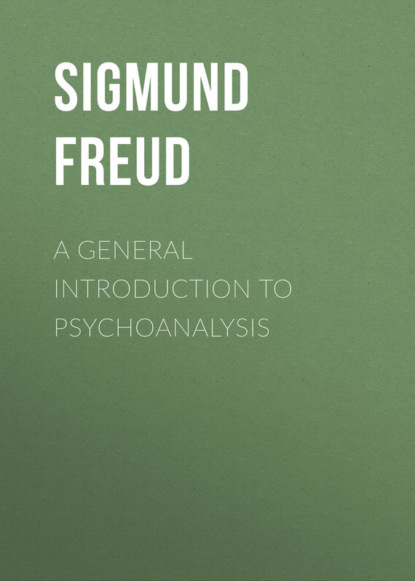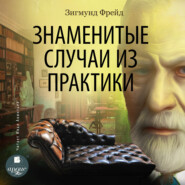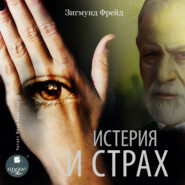По всем вопросам обращайтесь на: info@litportal.ru
(©) 2003-2024.
✖
A General Introduction to Psychoanalysis
Настройки чтения
Размер шрифта
Высота строк
Поля
There is something else that makes the symptoms appear remarkable and inexplicable as a means of libidinous satisfaction. They in no way recall anything from which we normally are in the habit of expecting satisfaction. They usually require no object, and thereby give up all connection with external reality. We understand this to be a result of turning away from fact and of returning to the predominance of pleasurable gratification. But it is also a return to a sort of amplified autoeroticism, such as was yielded the sex impulse in its earliest satisfactions. In the place of a modification in the outside world, we have a physical change, in other words, an internal reaction in place of an external one, an adjustment instead of an activity. Viewed from a phylogenetic standpoint, this expresses a very significant regression. We will grasp this better when we consider it in connection with a new factor which we are still to discover from the analytic investigation of symptom development. Further, we recall that in symptom formation the same processes of the unconscious have been at work as in dream formation – elaboration and displacement. Similarly to the dream, the symptom represents a fulfillment, a satisfaction after the manner of the infantile; by the utmost elaboration this satisfaction can be compressed into a single sensation or innervation, or by extreme displacement it may be restricted to a tiny element of the entire libidinous complex. It is no wonder that we often have difficulties in recognizing in the symptom the libidinous satisfaction which we anticipate and always find verified.
I have indicated that we must still become familiar with a new factor. It is something really surprising and confusing. You know that by analysis of the symptoms we arrive at a knowledge of the infantile experiences upon which the libido is fixated and out of which the symptoms are formed. Well, the surprising thing is this, that these infantile scenes are not always true. Indeed, in the majority of cases they are untrue, and in some instances they are directly contrary to historical truth. You see that this discovery, as no other, serves either to discredit the analysis which has led to such a result, or to discredit the patients upon whose testimony the analysis, as well as the whole understanding of neuroses, is built up. In addition there is something else utterly confusing about it. If the infantile experiences, revealed by analysis, were in every case real, we should have the feeling of walking on sure ground; if they were regularly falsified, disclosed themselves as inventions or phantasies of the patients, we should have to leave this uncertain ground and find a surer footing elsewhere. But it is neither the one nor the other, for when we look into the matter we find that the childhood experiences which are recalled or reconstructed in the course of the analysis may in some in some instances be false, in others undeniably true, and in the majority of cases a mixture of truth and fiction. The symptoms then are either the representation of actual experiences to which we may ascribe an influence in the fixation of the libido, or the representation of phantasies of the patient which, of course, can be of no etiological significance. It is hard to find one's way here. The first foothold is given perhaps by an analogous discovery, namely, that the same scattered childhood memories that individuals always have had and have been conscious of prior to an analysis may be falsified as well, or at least may contain a generous mixture of true and false. Evidence of error very seldom offers difficulties, and we at least gain the satisfaction of knowing that the blame for this unexpected disappointment is not to be laid at the door of analysis, but in some way upon the patients.
After reflecting a bit we can easily understand what is so confusing in this matter. It is the slight regard for reality, the neglect to keep fact distinct from phantasy. We are apt to feel insulted that the patient has wasted our time with invented tales. There is an enormous gap in our thinking between reality and invention and we accord an entirely different valuation to reality. The patient, too, takes this same viewpoint in his normal thinking. When he offers the material which, by way of the symptom, leads back to the wish situations which are modeled upon the childhood experiences, we are at first, to be sure, in doubt whether we are dealing with reality or with phantasy. Later certain traits determine this decision; we are confronted with the task of acquainting the patient with them. This can never be accomplished without difficulty. If at the outset we tell him that he is going to reveal phantasies with which he has veiled his childhood history, just as every people weaves myths around its antiquity, we notice (to our comfort) that his interest in the further pursuit of the subject suddenly diminishes. He, too, wants to discover realities, and despises all "notions." But if until this is accomplished we allow him to believe that we are investigating the actual occurrences of his childhood, we run the risk of later being charged with error and with our apparent gullibility. For a long time he is unable to reconcile himself to the idea of considering phantasy and reality on equal terms and he tends, with reference to the childish experiences to be explained, to neglect for the time being the difference between the real and the imaginary. And yet this is obviously the only correct attitude toward these psychological products because they are, in a sense, real. It is a fact that the patient is able to create such phantasies for himself, and this is of scarcely less importance for his neurosis than if he had really undergone the experience which he imagines. These phantasies possess psychological reality in contrast to physical reality, and so we gradually come to understand that in the realm of neuroses the psychological reality is the determining factor.
Among the experiences which recur continually in the early history of neurotics and, in fact, are never lacking, some are of particular significance and accordingly I consider them worthy of special treatment. I shall enumerate a few examples of this species: observation of the parental intercourse, seduction by an adult, and the threat of castration. It would be a grievous error to assume that physical reality can never be accorded them; this may often be proved beyond doubt by the testimony of adult relatives. So, for example, it is not at all unusual if the little boy who begins to play with his penis, and does not yet know that one must conceal this, is threatened by his parents or nurse with the cutting off of the organ or the guilty hand. Parents often admit upon questioning that they thought they had done the right thing by this intimidation; many individuals retain a correct, conscious memory of these threats, especially if it has occurred in later childhood. When the mother or some other woman makes the threat she usually delegates the responsibility of executing it to the father or to the doctor. In the famous Struwelpeter by the pediatrist Hoffman, of Frankfort, rhymes which owe their popularity to his very fine understanding of the sexual and other complexes of childhood, you find a milder substitute for castration in the cutting off of the thumbs as a punishment for insistent sucking. But it is highly improbable that the threat of castration is actually made as often as it occurs in the analyses of neurotics. We are content to understand that the child imaginatively constructs this threat for himself from suggestions, from the knowledge that auto-erotic satisfaction is forbidden, and from the impression of castration he has received in discovering the female genital. It is, moreover, in no way impossible that the little child, so long as he is not credited with any understanding or memory, will, even in families outside the proletariat, become a witness to the sexual act between his parents or some other group-ups, and it cannot be disproved that the child subsequently understands this impression, and may react upon it. But when this intercourse is described with minute details which could hardly have been observed, or if it turns out to be, as it so frequently does, an intercourse which was not face to face, more ferarum, there is no longer any doubt that this phantasy is derived from the observation of the intercourse of animals (dogs) and the unsatisfied curiosity of the child in his period of puberty. The greatest feat of the imagination is the phantasy of having witnessed the coitus of the parents while still unborn in the mother's womb. Of especial interest is the phantasy of having been seduced, because so often it is not a phantasy at all, but a real memory. But luckily it is not real so often as first appears from the results of analysis. Seduction by older children, or children of the same age, is much more frequent than seduction by adults, and if, in the case of little girls, the father quite regularly appears as the seducer in the occurrences which they relate, neither the fantastic nature of this accusation nor its motive can be doubted. The child as a rule covers the autoerotic period of his sexual activity, where there has been no actual seduction, with the seduction-phantasy. He spares himself the shame of onanism by imagining the presence of an object for his desires in that early period. As a matter of fact, you must not be misled in attributing sexual misuse of the child by its nearest male relatives solely and always to phantasy. Most analysts have probably treated cases in which such relations were real and could be proved beyond doubt, with the qualification that in such cases they belong to the later years of childhood and were transposed to an earlier time.
We cannot avoid the impression that such experiences of childhood are in some way necessary to the neurosis, that they are claimed by its iron rule. If they exist in reality, then well and good, but if reality has withheld them they are constructed from suggestions and supplemented by the imagination. The result is the same, and to this day we have been unable to trace any difference in the results, whether fancy or fact played the larger part in these childish occurrences. Here again we encounter one of the complementary relationships so frequently met with; it is, to be sure, the most estranging of all those we have become acquainted with. Whence comes the need for these phantasies, and the material for them? There can be no doubt as to the sources of the impulse, but we must explain why the same phantasies are always created with the same content. I have an answer in readiness which I know you will think very far-fetched. I am of the opinion that these primal phantasies– so I should like to term these, and certainly some others also – are a phylogenetic possession. In them the individual reaches out beyond his own life, into the experiences of antiquity, where his own experience has become all too rudimentary. It seems very possible to me that everything which is obtained during an analysis in the guise of phantasy, the seduction of children, the release of sexual excitement by watching parental intercourse, the threat of castration – or rather castration itself – were once realities in the primeval existence of mankind and that the imaginative child is merely filling in the gaps of individual truth with prehistoric truth. We have again and again suspected that the psychology of neuroses stores up more of the antiquities of human development than all other sources.
What we have just discussed makes it necessary for us to enter further into the origin and significance of that mental activity that is called imagination. As you well know, it enjoys universal esteem, although we have never clearly understood its place in the psychic life. I have this much to say about it. As you know, the ego of man is slowly educated by the influence of external necessity to an appreciation of reality and a pursuit of the principle of reality, and must therefore renounce temporarily or permanently various objects and goals of its strivings for satisfaction, sexual and otherwise. But renunciation of gratification has always been difficult for man. He cannot accomplish it without something in the nature of compensation. Accordingly he has reserved for himself a psychological activity wherein all these abandoned sources of pleasures and means of pleasurable gratification are granted a further existence, a form of existence in which they are freed from the requirements of reality and what we like to call the test of reality. Every impulse is soon transformed into the form of its own fulfillment. There is no doubt that dwelling on the imagined fulfillment of a given wish affords some satisfaction, although the realization that it is unreal is unobscured. In the activity of the imagination, man enjoys that freedom from external compulsion that he has long since renounced. He has made it possible to be alternately a pleasure-seeking animal and a reasoning human being. He finds that the scant satisfaction that he can force out of reality is not enough. "There is no getting along without auxiliary-constructions," Th. Fontaine once said. The creation of the psychic realm of fancy has its complete counterpart in the establishment of "preserves" and "conservation projects" in those places where the demands of husbandry, traffic and industry threaten quickly to change the original face of the earth into something unrecognizable. The national reserves maintain this old condition of things, which otherwise has everywhere been regretfully sacrificed to necessity. Everything may grow and spread there as it will, even that which is useless and harmful. The psychic realm of phantasy is such a reservation withdrawn from the principles of reality.
The best known productions of phantasy are the so-called "day dreams," which we already know, pictured satisfactions of ambitious, of covetous and erotic wishes, which flourish the more grandly the more reality admonishes them to modesty and patience. There is unmistakably shown in them the nature of imaginative happiness, the restoration of the independence of pleasurable gratification from the acquiescence of reality. We know such day dreams are nuclei and models for the dreams of night. The night dream is essentially nothing but a day dream, distorted by the nocturnal forms of psychological activity, and made available by the freedom which the night gives to instinctive impulses. We have already become acquainted with the idea that a day dream is not necessarily conscious, that there are also unconscious day dreams. Such unconscious day dreams are as much the source of night dreams as of neurotic symptoms.
The significance of phantasy for the development of symptoms will become clear to you by the following: We have said that in a case of renunciation, the libido occupies regressively the positions once abandoned by it, to which, nevertheless, it has clung in certain ways. We shall neither retract this statement nor correct it, but we shall insert a missing link. How does the libido find its way to these points of fixation? Well, every object and tendency of the libido that has been abandoned, is not abandoned in every sense of the word. They, or their derivatives, are still held in presentations of the phantasy, with a certain degree of intensity. The libido need only retire to the imagination in order to find from them the open road to all suppressed fixations. These phantasies were happy under a sort of tolerance, there was no conflict between them and the ego, no matter how acute the contrast, so long as a certain condition was observed – a condition quantitative in nature that is now disturbed by the flowing back of the libido to the phantasies. By this addition the accumulation of energy in the phantasies is heightened to such a degree that they become assertive and develop a pressure in the direction of realization. But that makes a conflict between them and the ego inevitable. Whether formerly conscious or unconscious, they now are subject to suppression by the ego and are victims to the attraction of the unconscious. The libido wanders from phantasies now unconscious to their sources in unconsciousness, and back to its own points of fixation.
The return of the libido to phantasy is an intermediate step on the road to symptom development and well deserves a special designation. C. G. Jung coined for it the very appropriate name of introversion, but inappropriately he also lets it stand for other things. Let us therefore retain the idea that introversion signifies the turning aside of the libido from the possibilities of actual satisfaction and the excessive accumulation of the phantasies hitherto tolerated as harmless. An introvert is not yet a neurotic, but he finds himself in a labile situation; he must develop symptoms at the next dislocation of forces, if he does not find other outlets for his pent-up libido. The intangible nature of neurotic satisfaction and the neglect of the difference between imagination and reality are already determined by arrest in the phase of introversion.
You have certainly noticed that in the last discussions I have introduced a new factor into the structure of the etiological chain, namely, the quantity, the amount of energy that comes under consideration. We must always take this factor into account. Purely qualitative analysis of the etiological conditions is not sufficient. Or, to put it in another way, a dynamic conception alone of these psychic processes is not enough; there is need of an economic viewpoint. We must say to ourselves that the conflict between two impulses is not released before certain occupation-intensities have been reached, even though the qualitative conditions have long been potent. Similarly, the pathogenic significance of the constitutional factors is guided by how much more of a given component impulse is present in the predisposition over and above that of another; one can even conceive the predispositions of all men to be qualitatively the same and to be differentiated only by these quantitative conditions. The quantitative factor is no less important for the power of resistance against neurotic ailments. It depends upon what amount of unused libido a person can hold freely suspended, and upon how large a fraction of the libido he is able to direct from the sexual path to the goal of sublimation. The final goal of psychological activity, which may be described qualitatively as striving towards pleasure-acquisition and avoidance of unpleasantness, presents itself in the light of economic considerations as the task of overcoming the gigantic stimuli at work in the psychological apparatus, and to prevent those obstructions which cause unpleasantness.
So much I wanted to tell you about symptom development in the neuroses. Yes, but do not let me neglect to emphasize this especially: everything I have said here relates to the symptom development in hysteria. Even in compulsion neuroses, which retain the same fundamentals, much is found that is different. The counter-siege directed against the claims of the instincts, of which we have spoken in connection with hysteria, press to the fore in compulsion neuroses, and control the clinical picture by means of so-called "reaction-formations." The same kind and more far-reaching variations are discoverable among the other neuroses, where the investigations as to the mechanism of symptom development have in no way been completed.
Before I leave you today I should like to have your attention for a while for an aspect of imaginative life which is worthy of the most general interest. For there is a way back from imagination to reality and that is – art. The artist is an incipient introvert who is not far from being a neurotic. He is impelled by too powerful instinctive needs. He wants to achieve honor, power, riches, fame and the love of women. But he lacks the means of achieving these satisfactions. So like any other unsatisfied person, he turns away from reality, and transfers all his interests, his libido, too, to the elaboration of his imaginary wishes, all of which might easily point the way to neurosis. A great many factors must combine to present this termination of his development; it is well known how often artists especially suffer from a partial inhibition of their capacities through neurosis. Apparently their constitutions are strongly endowed with an ability to sublimize and to shift the suppression determining their conflicts. The artist finds the way back to reality in this way. He is not the only one who has a life of imagination. The twilight-realm of phantasy is upheld by the sanction of humanity and every hungry soul looks here for help and sympathy. But for those who are not artists, the ability to obtain satisfaction from imaginative sources is very restricted. Their relentless suppressions force them to be satisfied with the sparse day dreams which may become conscious. If one is a real artist he has more at his disposal. In the first place, he understands how to elaborate his day dreams so that they lose their essentially personal element, which would repel strangers, and yield satisfaction to others as well. He also knows how to disguise them so that they do not easily disclose their origin in their despised sources. He further possesses the puzzling ability of molding a specific material into a faithful image of the creatures of his imagination, and then he is able to attach to this representation of his unconscious phantasies so much pleasurable gratification that, for a time at least, it is able to outweigh and release the suppressions. If he is able to accomplish all this, he makes it possible for others, in their return, to obtain solace and consolation from their own unconscious sources of gratification which had become inaccessible. He wins gratitude and admiration for himself and so, by means of his imagination, achieves the very things which had at first only an imaginary existence for him: honor, power, and the love of women.
TWENTY-FOURTH LECTURE
GENERAL THEORY OF THE NEUROSES
Ordinary Nervousness
IN our last discussion we accomplish a difficult task. Now I shall temporarily leave our subject and address myself to you.
For I know quite well that you are dissatisfied. You thought that an introduction to psychoanalysis would be quite a different matter. You expected to hear vivid illustrations instead of theories. You will tell me that when I gave you the illustration of "on the ground floor in the first story," you had grasped something of the causation of neurosis, only of course this should have been a real observation and not an imaginary story. Or, when in the beginning I described two symptoms (not imaginary also, let us hope) whose analysis revealed a close connection with the life of the patient, you first came to grasp the meaning of the symptoms and you hoped that I would proceed in the same way. Instead I have given you theories – lengthy, difficult to see in perspective and incomplete, to which something new was constantly being added. I worked with conceptions that I had not previously presented to you, abandoned descriptive for dynamic conceptions, and these in turn for economic ones. I made it hard for you to understand how many of the artificial terms I made use of still carry the same meaning and are used interchangeably only for the sake of euphony. Finally, I allowed broad conceptions to pass in review before you: the principles of pleasure and of fact and their phylogenetically inherited possession; and then, instead of introducing you to definite facts, I allowed them to become increasingly vague till they seemed to fade into dim distances.
Why did I not begin my introduction to the theory of neurosis with the facts that you yourselves know about nervousness, with something that has always aroused your interest, with the peculiar temperament of nervous people, their incomprehensible reactions to external influences, to human intercourse, their irritability, their uselessness? Why did I not lead you step by step from the understanding of simple, everyday forms to the problems of mysterious and extreme manifestations of nervousness?
I cannot even say that you are wrong. I am not so infatuated with my art of representation as to see some special attraction in every blemish. I myself believe that I could have proceeded differently, to your better advantage, and this indeed had been my intention. But one cannot always carry out one's sensible intentions. The nature of the subject matter issues its own commands, and easily modifies our plans. Even so usual a performance as the organization of well-known material is not entirely subject to the particular purposes of the author. It forms itself as it will and later one wonders why it turned out so and not otherwise.
Probably one of the reasons is that the title, A General Introduction to Psychoanalysis, no longer applies to this part, which deals with the neuroses. The introduction to psychoanalysis is found in the study of errors and the dream; the theory of neurosis is psychoanalysis itself. I do not think that in so short a time I could have given you a knowledge of the theory of neurosis other than in concentrated form. It was necessary to present to you connectedly the meaning and interpretation of the symptoms, their external and internal conditions and their bearing on the mechanism of symptom formation. This I have attempted to do; it is practically the nucleus of the material that modern psychoanalysis is able to offer. We had to say quite a good deal concerning the libido and its development, and something as well concerning the development of the ego. The introduction had already prepared you for the presuppositions of our technique, for the large aspects of the unconscious and of suppression (resistance). In a subsequent lecture you will learn from what points psychoanalysis proceeds organically. For the present I have not sought to hide from you the fact that all our results are based on the study of a single group of nervous affections, the so-called transference neuroses. Though you have gained no positive knowledge and have not retained every detail, still I hope that you have a fair picture of the methods, the problems and the results of psychoanalysis.
I have assumed that it was your wish for me to begin my presentation of neuroses with a description of nervous behavior, the nature of neurotic suffering, and the way in which the nervous meet the conditions of their illness and adapt themselves to these. Such subject matter is certainly interesting and well worth knowing. It is moreover not very hard to handle, yet it is not wise to begin with its consideration. There is danger of not discovering the unconscious, of overlooking the great significance of the libido, of judging all conditions as they appear to the ego of the nervous person. It is obvious that this ego is neither a reliable nor an impartial authority. For this very ego is the force that denies and suppresses the unconscious; when the unconscious is concerned, how then could we expect justice to be done? The rejected claims of sexuality stand first in the line of these suppressions; it is natural that from the standpoint of the ego we can never learn their extent and significance. As soon as we attain to the point of view of suppression, we are sufficiently warned not to make one of the contending factions, above all not to make the victor judge of the struggle. We are prepared to find that the testimony of the ego may lead us astray. If one is to believe the evidence of the ego, it would appear to have been active all along, all its symptoms would have been actively willed and formed. Yet we know that it has passively allowed a great deal to occur, a fact which it subsequently seeks to conceal and to palliate. To be sure, it does not always attempt this; in the case of the symptoms of compulsion neurosis it must admit that it is being opposed by something alien, which it can resist only with difficulty.
Whoever does not heed these warnings not to mistake the prevarications of the ego for truth, has clear sailing; he avoids all the resistances which oppose the psychoanalytic emphasis upon the unconscious, on sexuality, and on the passiveness of the ego. He will assert with Alfred Adler that the "nervous character" is the cause instead of the result of the neurosis, but he will not be able to explain a single detail of symptom formation or to interpret a single dream.
You will ask: Is it not possible to do justice to the part the ego plays in nervousness and in symptom formation without crudely neglecting the factors revealed by psychoanalysis? I answer you: Surely it must be possible and at some time or other it will take place; but the methods by which we organize the work of psychoanalysis do not favor our beginning with just this task. We can foresee the time when this task will claim the attention of psychoanalysis. There are forms of neuroses, the so-called narcistic neuroses, in which the ego is far more deeply involved than in anything we have studied heretofore. The analytic investigation of these conditions will enable us to judge reliably and impartially the part that the ego plays in neurotic illness.
One of the relations which the ego bears to its neurosis is so obvious that it must be considered at the very outset. In no case does it seem to be absent, and it is most clearly recognizable in the traumatic neuroses, conditions which we do not as yet clearly understand. You must know that in the causation and mechanisms of all possible forms of neurosis, the same factors are active again and again; it is only the emphasis that is shifted from one to the other of these factors in symptom formation. The members of a company of actors each have certain parts to play – hero, villain, confidant, etc. – yet each will select a different drama for his benefit. Thus the phantasies which undergo conversion into symptoms are especially easy to detect in hysteria; compulsion neuroses are essentially dominated by the reactionary formations, or counter-seizures of the ego; what we designate as secondary elaboration in dreams dominates paranoia in the form of delusions, etc.
In traumatic neuroses, particularly if they are caused by the horrors of war, we are especially impressed by a selfish ego-impulse which seeks protection and personal advantage. This in itself is not a sufficient cause for illness, but it can favor its beginning and also feed its needs once it has been established. This motive serves to protect the ego from the dangers whose imminence precipitated the disease, and does not permit convalescence until the recurrence of these dangers seems impossible, or until compensation has been obtained for the danger that has been undergone.
But the ego betrays similar interest in the origin and maintenance of all other neuroses. We have already said that the ego suffers the symptom to exist, because one of its phases gratifies the egoistic tendency toward suppression. Besides, the ending of the conflict by means of symptom development is the path of least resistance, and a most convenient solution for the principle of pleasure. Through symptom formation the ego is undoubtedly spared a severe and unpleasant inner task. There are cases where even the physician must admit that the resolution of the conflict into neurosis is the most harmless outcome and one most easily tolerated by society. Do not be surprised, then, to learn that occasionally even the physician takes the part of the illness he is battling against. He does not have to restrict himself to the role of the fanatic warrior for health in all situations of life. He knows that the world contains not only neurotic misery, but also real, incurable suffering. He knows that necessity may even require a human being to sacrifice his health, and he learns that by this sacrifice on the part of one individual untold wretchedness may be spared for many others. So if we say that the neurotic escapes the conflict by taking refuge in illness, we must admit that in some cases this escape is justifiable, and the physician who has diagnosed the state of affairs will retire silently and tactfully.
But let us not consider these special cases in our further discussion. In average cases the ego, by having recourse to neurosis, obtains a certain inner advantage from the disease. Under certain conditions of life, there may also be derived a tangible external advantage, more or less valuable in reality. Let me direct your attention to the most frequent occurrences of this sort. Women who are brutally treated and mercilessly exploited by their husbands almost always adopt the evasion of the neurosis, provided that their predisposition permits this. This usually follows when the woman is too cowardly or too virtuous to seek secret solace in the arms of another, or when she dare not separate from her husband in the face of all opposition, when she has no prospect of maintaining herself or of finding a better husband and especially when her sexual emotions still bind her to this brutal man. Her illness becomes a weapon in her struggle with him, one that she can use for self-protection and misuse for purposes of vengeance. She probably dare not complain of her marriage, but she can complain of her illness. The doctor becomes her assistant. She forces her inconsiderate husband to spare her, to attend to her wishes, to permit her absence from the house and thus free her from the oppressions of her married life. Wherever such external or accidental gain through illness is considerable and can find no substitute in fact, you can prophesy that the possibility of influencing neurosis through therapy is very slight.
You will tell me that what I have said about the advantage gained from the disease speaks entirely for the hypothesis I have rejected, namely, that the ego itself wills and creates the neurosis. Just a moment! It probably does not mean more than that the ego passively suffers the neurosis to exist, which it is unable to prevent anyway. It makes the most of the neurosis, if anything can be made of it at all. This is only one side of the question, the advantageous side. The ego is willing to endure the advantages of the neurosis, but there are not only advantages. As a rule it soon appears that the ego has made a poor deal in accepting the neurosis. It has paid too high a price for the mitigation of the conflict; and the sensations of suffering which the symptoms bring with them are perhaps every bit as bad as the agonies of conflict, usually they cause even greater discomfort. The ego wants to rid itself of the pain of the symptoms without relinquishing the gain of illness, and that is impossible. Thus the ego is discovered as by no means so active as it had thought itself to be, and this we want to keep in mind.
If you were to come into contact with neurotics as a physician, you would soon cease to expect that those who complain most woefully of their illness are the ones who will oppose its therapy with the least resistance or who will welcome any help. On the contrary, you would readily understand that everything contributing to the advantage derived from the disease will strengthen the resistance to the suppression and heighten the difficulty of the therapy. We must also add another and later advantage to the gain of illness which is born with the symptom. If a psychic organization, such as this illness, has persisted for a long time, it finally behaves as an independent unit, it expresses something like self-preservation, attains a kind of modus vivendi between itself and other parts of psychic life, even those that are fundamentally hostile to it. And occasions will probably arise where it can prove again to be both useful and valuable, by which it will attain a secondary function, which gives strength to its existence. Instead of an illustration from pathology take a striking example from everyday life. An efficient workman who earns his living is crippled for his occupation by some disaster; his work is over for him. After a while, however, he receives a small accident insurance, and learns to exploit his injury by begging. His new existence, though most undesirable, is based upon the very thing that robbed him of his former maintenance. If you could cure his defect, he would be without a means of subsistence, he would have no livelihood. The question would arise: Is he capable of resuming his former work? That which corresponds to such secondary exploitation of illness in neurosis we may add to the primary benefit derived therefrom and may term it a secondary advantage of disease.
In general I should like to warn you not to underestimate the practical significance of the advantage from illness and yet not to be too much impressed by it theoretically. Aside from the previously recognized exceptions, I am always reminded of Oberländer's pictures on "the intelligence of animals" which appeared in the Fliegende Blätter. An Arab is riding a camel on a narrow path cut through a steep mountain side. At a turn of the trail he is suddenly confronted by a lion who makes ready to spring. He sees no way out, on one side the precipice, on the other the abyss; retreat and flight – both are impossible; he gives himself up as lost. Not so the camel. He leaps into the abyss with his rider – and the lion is left in the lurch. The help of neurosis is as a rule no kinder to the rider. It may be due to the fact that the settlement of the conflict through symptom development is nevertheless an automatic process, not able to meet the demands of life, and for whose sake man renounces the use of his best and loftiest powers. If it were possible to choose, it were indeed best to perish in an honorable struggle with destiny.
I still owe you further explanation as to why, in my presentation of the theory of neurosis, I did not proceed from ordinary nervousness as a starting point. You may assume that, had I done this, the proof of the sexual origin of neurosis would have been more difficult for me, and so I refrained. There you are mistaken. In transference neurosis we must work at interpretations of the symptoms to arrive at this conclusion. In the ordinary forms of the so-called true neuroses, however, the etiological significance of sexual life is a crude fact open to observation. I discovered it twenty years ago when I asked myself one day why we regularly barred out questions concerning sexual activity in examining nervous patients. At that time I sacrificed my popularity among my patients to my investigations, yet after a brief effort I could state that no neurosis, no true neurosis at least, is present with a normal sexual life. Of course, this statement passes too lightly over the individual differences, it is unclear through the vagueness with which it uses the term "normal," but even to-day it retains its value for purposes of rough orientation. At that time I reached the point of drawing comparisons between certain forms of nervousness and sexual abnormalities, and I do not doubt that I could repeat the same observations now, if similar material were at my disposal. I frequently noticed that a man who contented himself with incomplete sexual gratification, with manual ononism, for instance, would suffer from a true neurosis, and that this neurosis would promptly give way to another form, if another sexual regime no less harmful were substituted. From the change in the condition of the patient I was able to guess the change in the mode of his sexual life. At that time I learned to hold obstinately to my conjectures until I had overcome the patient's prevarications and had forced him to confirm my suppositions. To be sure, then he preferred to consult other physicians who did not inquire so insistently into his sexual life.
At that time it did not escape my notice that the origin of the disease could not always be traced back to sexual life; sexual abnormality would cause the illness in one person, while another would fall ill because he had lost his fortune or had suffered an exhausting organic disease. We gained insight into this variation by means of the interrelations between the ego and the libido, and the more profound our insight became, the more satisfactory were the results. A person begins to suffer from neurosis when his ego has lost the capacity of accommodating the libido. The stronger the ego, the easier the solution of the problem; a weakening of the ego from any cause whatsoever has the same effect as a superlative increase of the claims of the libido. There are other and more intimate relations between the ego and the libido which I shall not discuss, as we are not concerned with them here. To us it is of enlightening significance that in every case, regardless of the way in which the illness was caused, the symptoms of neurosis were opposed by the libido and thus gave evidence for its abnormal use.
Now, however, I want to draw your attention to the difference between the symptoms of the true neuroses and the psychoneuroses, the first group of which, the transference neurosis, has occupied us considerably. In both cases the symptoms proceed from the libido. They are accordingly abnormal uses of it, substitutes for gratification. But the symptoms of the true neurosis – such as pressure in the head, sensations of pain, irritability of an organ, weakening or inhibition of a function – these have no meaning, no psychic significance. They are manifested not only in the body, as for instance hysteric symptoms, but are in themselves physical processes whose creation is devoid of all the complicated psychic mechanism with which we have become acquainted. They really embody the character that has so long been attributed to the psychoneurotic symptom. But how can they then correspond to uses of the libido, which we have come to know as a psychological force? That is quite simple. Let me recall one of the very first objections that was made to psychoanalysis. It was stated that psychoanalysis was concerned with a purely psychological theory of neurotic manifestations; that this was a hopeless outlook since psychological theories could never explain illness. The objectors chose to forget that the sexual function is neither purely psychic nor merely somatic. It influences physical as well as psychic life. In the symptoms of the psychoneuroses we have recognized the expression of a disturbance in psychic processes. And so we shall not be surprised to discover that the true neuroses are the direct somatic consequences of sexual disturbances.
The medical clinic gives us a valuable suggestion (observed by many research workers) for the comprehension of the true neuroses. In all the details of their symptomatology, and as well in their characteristic power to influence all organic systems and all functions, the true neuroses reveal a marked similarity to the conditions of those diseases which originate through the chronic influence of foreign poisons and as well through their acute diminution; with conditions prevalent in intoxication and abstinence. The two groups of conditions are brought still closer together by the relation of intermediate conditions, which, following M. Basedowi, we have learned to attribute to the influence of toxic substances, but of toxins, however, which are not introduced into the body from without, but arise in its own metabolism. These analogies, I think, lead us directly to the consideration of these neuroses as disturbances in sexual metabolism. It may be that more sexual toxins are produced than the individual can dispose of, or that inner, even psychic conditions, stand in the way of the proper elaboration of these substances. The language of the people has always favored such assumptions as to the nature of sexual desires. It calls love an "intoxication"; it will have love-madness aroused through potions, and thus sees the motive force removed, as it were, to the outer world. For the rest, the phrase "sexual metabolism" or "chemism of sexuality" is a chapter-head without content. We know nothing about it and cannot even decide whether we are to assume two sexual substances, the male and the female, or, if there is only one sexual toxin, which to consider the carrier of all the stimulating power of the libido. The structure of psychoanalysis that we have erected is really only a superstructure which at some future time must be placed upon its organic foundation; but what this is we do not know as yet.
Psychoanalysis is characterized as a science, not by reason of the subject matter it handles but by the technique it employs. This can be employed in dealing with the history of civilization, the science of religion or mythology, as well as with the theory of neurosis, without altering its character. The revealing of the unconscious in psychic life is all it aims to accomplish. The problems of the true neuroses, whose symptoms probably originate in direct toxic damage, yield no point of attack to psychoanalysis. Psychoanalysis can do little for their elucidation, and must leave the task to biological-medical research. Perhaps you understand now why I did not choose to organize my material differently. If I had given to you an Introduction to the Theory of the Neuroses as you wished, it would unquestionably have been correct to proceed from the simple forms of the true neuroses to those complex illnesses caused by a disturbance of the libido. In discussing the true neuroses I would have had to bring together the facts we have gleaned from various quarters and present what we think we know of them. Only later, under the psychoneuroses, would psychoanalysis have been discussed as the most important technical aid for insight into these conditions. I had, however, intended and announced A General Introduction to Psychoanalysis, and it seemed to me more important to give you an idea of psychoanalysis than to present certain positive facts about neuroses; and so I could not place the true neuroses into the foreground, for they prove sterile for the purposes of psychoanalysis. I believe that I have made the wiser choice for you, since psychoanalysis deserves the interest of every educated person because of its profound hypotheses and far-reaching connections. The theory of neurosis, on the other hand, is a chapter of medicine like any other.
You are, however, justified in expecting some interest on our part in the true neuroses. Because of their intimate connection with psychoneuroses we find this decidedly necessary. I shall tell you then that we distinguish three pure forms of true neuroses: neurasthenia, anxiety neurosis and hypochondria. Even this classification has not remained uncontradicted. The terms are all widely used, but their connotation is vague and uncertain. Besides, there are in this world of confusion physicians who object to any distinctions between manifestations, any emphasis of clinical detail, who do not even recognize the separation of true neuroses and psychoneuroses. I think they have gone too far and have not chosen the road which leads to progress. The types of neuroses we have mentioned occur occasionally in pure form; more often they are blended with one another or with a psychoneurotic condition. This need not discourage us to the extent of abandoning the task of distinction. Think of the difference between the study of minerals and that of ores in mineralogy. Minerals are described as individuals; frequently of course they occur as crystals, separated sharply from their surroundings. Ores consist of an aggregate of minerals which have coalesced not accidentally, but as a result of the conditions of their origin. We understand too little of the process of development of neuroses, to create anything similar to the study of ores. But we are surely working in the right direction when we isolate the known clinical factors, comparable to the separate minerals, from the great mass.
A noteworthy connection between the symptoms of the true neuroses and the psychoneuroses adds a valuable contribution to our knowledge of symptom formation in the latter. The symptom in the true neuroses is frequently the nucleus and incipient stage of development of the psychoneurotic symptom. Such a connection is most easily observed between neurasthenia and the transference neuroses, which are termed conversion hysteria, between anxiety neurosis and anxiety hysteria, but also between hypochondria and paraphrenia (dementia praecox and paranoia), forms of neuroses of which we shall speak subsequently. Let us take as an illustration the hysteric headache or backache. Analysis shows that through elaboration and displacement this pain has become the gratification substitute for a whole series of libidinous phantasies or reminiscences. But once upon a time this pain was real, a direct sexual toxic symptom, the physical expression of libidinous excitation. We do not wish to assert, by any means, that all hysteric symptoms can be traced to such a nucleus, but it is true that this is frequently the case, and that all influences upon the body through libidinous excitation, whether normal or pathological, are especially significant for the symptom development in hysteria. They play the part of the grain of sand which the mollusc has enveloped in mother-of-pearl. In the same way passing signs of sexual excitation, which accompany the sexual act, are used by psychoneurosis as the most convenient and appropriate material for symptom formation.
A similar procedure is of diagnostic and therapeutic interest especially. Persons who are disposed to be neurotic, without suffering from a flourishing neurosis, frequently set in motion the work of symptom development as the result of an abnormal physical change – often an inflammation or an injury. This development rapidly makes the symptom given by reality the representative of the unconscious phantasies that had been lurking for an opportunity to seize upon a means of expression. In such a case the physician will try different ways of therapy. Either he will try to do away with the organic basis without bothering about its noisy neurotic elaboration, or he will struggle with the neurosis brought out by the occasion, and ignore its organic cause. The result will justify now one, now the other method of procedure; no general laws can be laid down for such mixed cases.
TWENTY-FIFTH LECTURE
GENERAL THEORY OF THE NEUROSES
Fear and Anxiety
PROBABLY you will term what I told you about ordinary nervousness in my last lecture most fragmentary and unsatisfactory information. I know this, and I think you were probably most surprised that I did not mention fear, which most nervous people complain of and describe as their greatest source of suffering. It can attain a terrible intensity which may result in the wildest enterprises. But I do not wish to fall short of your expectations in this matter. I intend, on the contrary, to treat the problem of the fear of nervous people with great accuracy and to discuss it with you at some length.
Fear itself needs no introduction; everyone has at some time or other known this sensation or, more precisely, this effect. It seems to me that we never seriously inquired why the nervous suffered so much more and so much more intensely under this condition. Perhaps it was thought a matter of course; it is usual to confuse the words "nervous" and "anxious" as though they meant the same thing. That is unjustifiable; there are anxious people who are not nervous, and nervous people who suffer from many symptoms, but not from the tendency to anxiety.
However that may be, it is certain that the problem of fear is the meeting point of many important questions, an enigma whose complete solution would cast a flood of light upon psychic life. I do not claim that I can furnish you with this complete solution, but you will certainly expect psychoanalysis to deal with this theme in a manner different from that of the schools of medicine. These schools seem to be interested primarily in the anatomical cause of the condition of fear. They say the medulla oblongata is irritated, and the patient learns that he is suffering from neurosis of the nervus vague. The medulla oblongata is a very serious and beautiful object. I remember exactly how much time and trouble I devoted to the study of it, years ago. But today I must say that I know of nothing more indifferent to me for the psychological comprehension of fear, than knowledge of the nerve passage through which these sensations must pass.
One can talk about fear for a long time without even touching upon nervousness. You will understand me without more ado, when I term this fear real fear in contrast to neurotic fear. Real fear seems quite rational and comprehensible to us. We may testify that it is a reaction to the perception of external danger, viz., harm that is expected and foreseen. It is related to the flight reflex and may be regarded as an expression of the instinct of self-preservation. And so the occasions, viz., the objects and situations which arouse fear, will depend largely on our knowledge of and our feeling of power over the outer world. We deem it quite a matter of course that the savage fears a cannon or an eclipse of the sun, while the white man, who can handle the instrument and prophesy the phenomenon, does not fear these things. At other times superior knowledge promulgates fear, because it recognizes the danger earlier. The savage, for instance, will recoil before a footprint in the woods, meaningless to the uninstructed, which reveals to him the proximity of an animal of prey; the experienced sailor will notice a little cloud, which tells him of a coming hurricane, with terror, while to the passenger it seems insignificant.
After further consideration, we must say to ourselves that the verdict on real fear, whether it be rational or purposeful, must be thoroughly revised. For the only purposeful behavior in the face of imminent danger would be the cool appraisal of one's own strength in comparison with the extent of the threatening danger, and then decide which would presage a happier ending: flight, defense, or possibly even attack. Under such a proceeding fear has absolutely no place; everything that happens would be consummated just as well and better without the development of fear. You know that if fear is too strong, it proves absolutely useless and paralyzes every action, even flight. Generally the reaction against danger consists in a mixture of fear and resistance. The frightened animal is afraid and flees. But the purposeful factor in such a case is not fear but flight.
We are therefore tempted to claim that the development of fear is never purposeful. Perhaps closer examination will give us greater insight into the fear situation. The first factor is the expectancy of danger which expresses itself in heightened sensory attention and in motor tension. This expectancy is undoubtedly advantageous; its absence may be responsible for serious consequences. On the one hand, it gives rise to motor activity, primarily to flight, and on a higher plane to active defense; on the other hand, it gives rise to something which we consider the condition of fear. In so far as the development is still incipient, and is restricted to a mere signal, the more undisturbed the conversion of the readiness to be afraid into action the more purposeful the entire proceeding. The readiness to be afraid seems to be the purposeful aspect; evolution of fear itself, the element that defeats its own object.
I avoid entering upon a discussion as to whether our language means the same or distinct things by the words anxiety, fear or fright. I think that anxiety is used in connection with a condition regardless of any objective, while fear is essentially directed toward an object. Fright, on the other hand, seems really to possess a special meaning, which emphasizes the effects of a danger which is precipitated without any expectance or readiness of fear. Thus we might say that anxiety protects man from fright.
You have probably noticed the ambiguity and vagueness in the use of the word "anxiety." Generally one means a subjective condition, caused by the perception that an "evolution of fear" has been consummated. Such a condition may be called an emotion. What is an emotion in the dynamic sense? Certainly something very complex. An emotion, in the first place, includes indefinite motor innervations or discharges; secondly, definite sensations which moreover are of two kinds, the perception of motor activities that have already taken place, and the direct sensations of pleasure and pain, which give the effect of what we call its feeling tone. But I do not think that the true nature of the emotion has been fathomed by these enumerations. We have gained deeper insight into some emotions and realize that the thread which binds together such a complex as we have described is the repetition of a certain significant experience. This experience might be an early impression of a very general sort, which belongs to the antecedent history of the species rather than to that of the individual. To be more clear: the emotional condition has a structure similar to that of an hysterical attack; it is the upshot of a reminiscence. The hysteric attack, then, is comparable to a newly formed individual emotion, the normal emotion to an hysteria which has become a universal heritage.
Do not assume that what I have said here about emotions is derived from normal psychology. On the contrary, these are conceptions that have grown up with and are at home only in psychoanalysis. What psychology has to say about emotions – the James-Lange theory, for instance – is absolutely incomprehensible for us psychoanalysts, and cannot be discussed. Of course, we do not consider our knowledge about emotions very certain; it is a preliminary attempt to become oriented in this obscure region. To continue: We believe we know the early impression which the emotion of fear repeats. We think it is birth itself which combines that complex of painful feelings, of a discharge of impulses, of physical sensations, which has become the prototype for the effect of danger to life, and is ever after repeated within us as a condition of fear. The tremendous heightening of irritability through the interruption of the circulation (internal respiration) was at the time the cause of the experience of fear; the first fear was therefore toxic. The name anxiety – angustial – narrowness, emphasizes the characteristic tightening of the breath, which was at the time a consequence of an actual situation and is henceforth repeated almost regularly in the emotion. We shall also recognize how significant it is that this first condition of fear appeared during the separation from the mother. Of course, we are convinced that the tendency to repetition of the first condition of fear has been so deeply ingrained in the organism through countless generations, that not a single individual can escape the emotion of fear; not even the mythical Macduff who was "cut out of his mother's womb," and therefore did not experience birth itself. We do not know the prototype of the condition of fear in the case of other mammals, and so we do not know the complex of emotions that in them is the equivalent of our fear.

















